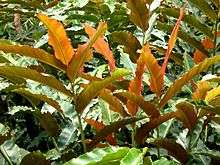Etlingera fulgens
Etlingera fulgens is a species of herbaceous perennial plant of the family Zingiberaceae. This species occurs in southern Thailand and peninsular Malaysia.[1] E. fulgens is used as an ornamental plant in landscape gardens for its bright red flowers and young leaves.
| Etlingera fulgens | |
|---|---|
 | |
| Scientific classification | |
| Kingdom: | Plantae |
| Clade: | Tracheophytes |
| Clade: | Angiosperms |
| Clade: | Monocots |
| Clade: | Commelinids |
| Order: | Zingiberales |
| Family: | Zingiberaceae |
| Genus: | Etlingera |
| Species: | E. fulgens |
| Binomial name | |
| Etlingera fulgens (Ridl.) C.K.Lim, 2000 | |
| Synonyms | |
|
Hornstedtia fulgens, Nicolaia fulgens, Phaeomeria fulgens | |
Description
Etlingera fulgens can be recognized by its shiny undulating leaves that are dark green in colour.[1][2] When young, the undersides of its leaves are bright red in color, turning greenish on maturing. In older leaves, only the petiole and midrib are red.[2] Petioles are 1.5–2.0 cm (0.6–0.8 in) in length. Rhizomes, 3 cm (1.2 in) in diameter, occur just below the ground. The plant can grow up to 5 m (16 ft) tall. Crushed leaf sheaths emit a pleasant sour fragrance similar to that of Etlingera elatior. Inflorescences are raised above the ground and infructescences are globular in shape.
Chemistry
Leaves of E. fulgens displayed stronger ferrous ion-chelating ability than young leaves of Camellia sinensis.[3] Chlorogenic acid found in leaves of E. fulgens was higher in content than Lonicera japonica (Japanese honeysuckle), the commercial source.[4] Fruit and rhizome oils of E. fulgens are mainly aliphatic hydrocarbons with cyclododecane, dodecanol, and cyclotetradecane as main constituents.[5] Oils of E. fulgens and E. elatior were very different in composition despite having very similar aroma. Oils of E. fulgens consist mainly of dodecyl acetate (21.6%), an ester, and pentadecanol (14.1%) and hexadecanol (3.60%), both long-chain alcohols.[4]
References
- Lim, C.K. (2000). "Taxonomic notes on Etlingera Giseke (Zingiberaceae) in Peninsular Malaysia: the Nicolaia taxa". Folia Malaysiana 1: 1–12.
- Khaw, S.H. (2001). "The genus Etlingera (Zingiberaceae) in Peninsular Malaysia including a new species". Gardens' Bulletin of Singapore. 53: 191–239.
- Chan, E.W.C., Lim, Y.Y., Omar, M. (2007). "Antioxidant and antibacterial activity of leaves of Etlingera species (Zingiberaceae) in Peninsular Malaysia". Food Chemistry 104 (4): 1586–1593. doi:10.1016/j.foodchem.2007.03.023.
- "Chan, E.W.C. (2009). "Bioactivities and chemical constituents of leaves of some Etlingera species (Zingiberaceae) in Peninsular Malaysia". Ph.D. thesis, Monash University, 305 p." Archived from the original on 2012-12-03. Retrieved 2010-02-08.
- Chua, L.S.L., Nor Azah, M.A., Sam, Y.Y., Mailina, J. (2005). "Wild gingers of Peninsular Malaysia: Conservation studies and investigation into their essential oils". In: Nor Azman, H. et al. (Eds.) Proceedings of the Eighth Malaysia Plan IRPA Seminar 2004, Forest Research Institute Malaysia.